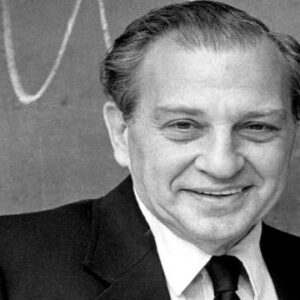Rudolph A. Marcus is a Canadian-American chemist who won the 1992 Nobel Prize in Chemistry for his work on electron transfer reactions in chemical systems. Marcus’s theory provides a framework for explaining a variety of fundamental phenomena, including photosynthesis, cell metabolism, and simple corrosion. He is particularly well-known for his work in the fields of transition-state theory and unimolecular reaction theory. He gained an early interest in science as a result of his two highly educated paternal uncles. Even though his parents were illiterate, they enthusiastically supported their son’s academic interests. Following graduation from high school, he enrolled at McGill University to study chemistry. He also took numerous maths courses. He later relocated to the United States for a postdoctoral research scholarship and became a citizen. He began exploring electron transfer processes and the effect of surrounding solvent molecules in determining the pace of redox reactions in the 1950s. He developed the Marcus theory, which is used to describe a variety of critical chemical and biological processes, including photosynthesis, corrosion, and certain types of chemiluminescence. Additionally, he constructed the Rice-Ramsperger-Kassel-Marcus theory by fusing RRK and transition state theories.
Childhood & Adolescence
Rudolph Arthur Marcus was born in Montreal, Quebec, on July 21, 1923. His parents were Esther (née Cohen) and Myer Marcus. He was reared in a loving household, praising his father’s physical prowess and his mother’s musical abilities.
Two of his uncles were eminent scholars, whom the little lad loved. He enjoyed school and developed an interest in both science and mathematics. After graduating from Byng High School, he enrolled at McGill University, the alma mater of the uncles he so adored.
Marcus gained valuable knowledge while studying at the university under Dr. Carl A. Winkler. While he was primarily a chemistry student, he attended some mathematics classes, which he later credited with assisting him in developing his theory of electron transfer. He received a B.Sc. in 1943 and a Ph.D. in 1946 for his thesis, ‘Studies on the conversion of PHX to AcAn.’
Rudolph Marcus’s Career
Rudolph A. Marcus joined the National Research Council (NRC) of Canada’s new post-doctoral program in Ottawa following the completion of his doctorate. E.W.R. Steacie led the photochemistry group and was instrumental in developing the NRC’s basic research agenda.
Marcus began applying for postdoctoral research fellowships to theorists in the United States in the late 1940s and obtained a favorable response from Oscar K. Rice at the University of North Carolina. He began his career as a theorist in 1949 after enrolling at the university and being exposed to theoretical study.
He developed the RRKM theory (“Rice-Ramsperger-Kassel-Marcus”) in the early 1950s by combining statistical concepts from the 1920s RRK theory with those from the mid-1930s transition state theory. The work was published for the first time in 1951, and the following year he created a generalization for other reactions.
He began his career as a totally autonomous researcher in 1951 when he joined the Polytechnic Institute of Brooklyn. In 1954-55, he conducted an experimental study on gas phase and solution reaction rates and published two publications on electrostatics.
He joined the faculty of the University of Illinois in Urbana-Champaign in 1964 and developed an interest in numerous elements of reaction dynamics, including the invention of “natural collision coordinates.” He visited Europe in 1975 as a Visiting Professor at the University of Oxford and later as a Humboldt Awardee at the Technical University of Munich. He initially encountered the difficulty of electron transfer in photosynthesis at Munich.
He joined the California Institute of Technology in 1978 as the Arthur Amos Noyes Professor of Chemistry. He is also currently a professor at Singapore’s Nanyang Technological University and a member of the International Academy of Quantum Molecular Science.
His Significant Works
Rudolph A. Marcus devised what became known as the Marcus hypothesis, a theory that explains the rates of electron transfer reactions – the rate at which an electron can travel or jump from one chemical species to another (referred to as the electron donor) (called the electron acceptor). Originally intended to handle outer sphere electron transfer reactions, it was eventually expanded to include contributions from the inner sphere electron transfer.
Marcus combined the Rice–Ramsperger–Kassel theory created by Rice and Ramsperger in 1927 and Kassel in 1928 with the Eyring. The theory permits straightforward estimations of unimolecular reaction rates to be computed from a few properties of the potential energy surface.
Awards and Accomplishments
Prior to obtaining the Nobel Prize, he had acquired a number of significant honors. Among them are the 1989 National Medal of Science, the American Chemical Society’s Irving Langmuir Award (1978), the Willard Gibbs Award (1988), the Theodore William Richards Award (1990), and the Pauling Medals (1991).
In 1992, Rudolph A. Marcus was awarded the Nobel Prize in Chemistry for “contributions to the theory of electron transfer processes in chemical systems.”
He is a 1970 inductee of the National Academy of Sciences, a 1973 inductee of the American Academy of Arts and Sciences, a 1990 inductee of the American Philosophical Society, and a 1987 Foreign Member of the Royal Society (ForMemRS).
Personal History and Legacies
In 1949, he married Laura Hearne and had three children. His wife died in 2003 after more than five decades of marriage.
Estimated Net worth
Rudolph is one of the wealthiest chemists and is mentioned on the list of the most popular chemists. According to our study, Rudolph Marcus’ net worth is around $1.5 million, as reported by Wikipedia, Forbes, and Business Insider.


